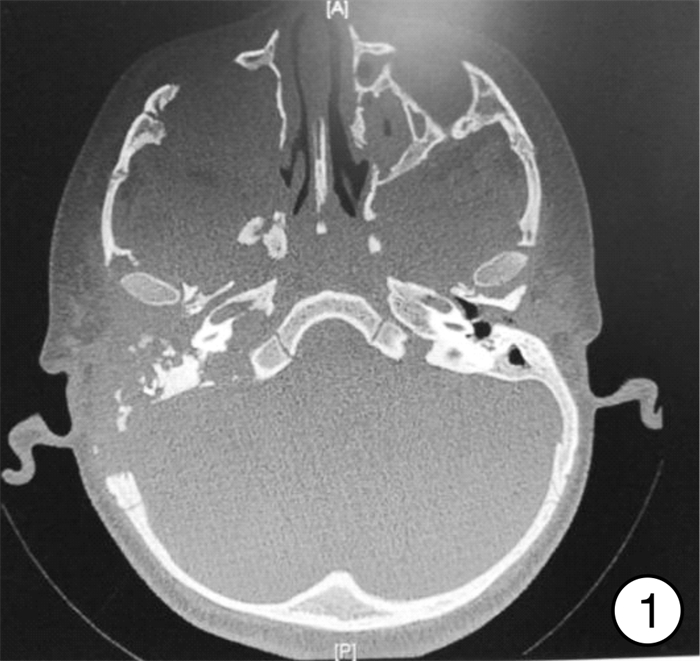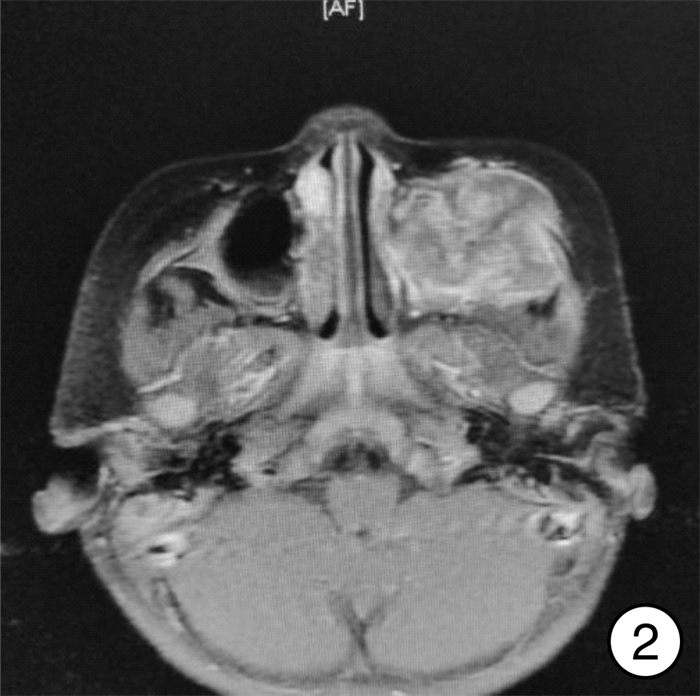Analysis of clinical features of Craniofacial Langerhans cell histiocytosis in children
-
摘要: 目的 探讨儿童颅面部朗格汉斯细胞组织细胞增生症(LCH)的临床特点。方法 回顾性分析11例经手术组织病理证实为颅面部LCH患儿的临床资料,分析其临床特点。结果 11例颅面部LCH患儿均有门诊误诊误治病史。10例发病年龄为1~4岁。9例发生于颞骨的LCH均有耳漏及中度至极重度的听力损失,6例为双耳受累。7例患儿的原发灶部位的局部CT有明显的较大范围骨质破坏。死亡2例(均为多发危险器官受累患儿),存活8例,失访1例。结论 儿童颅面部LCH主要发生于4岁以内儿童,颞骨LCH多为双耳受累,多有耳漏及严重的听力损失,由于局部的临床症状多不具有特异性,临床工作中有较高的误诊率,影像学检查及全身系统检查具有重要的诊断价值,危险器官受累患儿死亡率较高,化疗对病灶局限的患儿有较好的临床效果。
-
关键词:
- 颅面部 /
- 朗格汉斯细胞组织细胞增生症 /
- 儿童
Abstract: Objective To investigate the clinical features of craniofacial Langerhans cell histiocytosis(LCH) in children. Method The clinical data of 11 children with craniofacial LCH confirmed by surgical histopathology were analyzed retrospectively, and their clinical characteristics were compared. Result Eleven children with craniofacial LCH had a history of misdiagnosis and mistreatment. There were 10 cases aged 1-4 years. 9 cases of LCH occurred in the temporal bone with otorrhea and moderate to severe hearing loss, while 6 cases were binaural involvement. CT of the primary lesions in 7 children showed obvious extensive bone destruction. 2 cases died(both with multiple dangerous organs involved) and 8 cases survived. Conclusion The craniofacial LCH in children mainly occurs in children under 4 years old, Most of the temporal bone LCH is involved in both ears with otorrhea and severe hearing loss. There is a high rate of misdiagnosis in clinical work due to lack of specific clinical symptoms. Imaging examinations and systemic examinations have important diagnostic value. The cases with dangerous organs involved have a higher mortality rate, while chemotherapy has better clinical effect for children with localized lesions.-
Key words:
- craniofacial /
- Langerhans cell histiocytosis /
- child
-

-
[1] Monsereenusorn C, Rodriguez-Galindo C. Clinical Characteristics and Treatment of Langerhans Cell Histiocytosis[J]. Hematol Oncol Clin North Am, 2015, 29(5): 853-873. doi: 10.1016/j.hoc.2015.06.005
[2] 吴升华. 朗格罕细胞组织细胞增生症评估与治疗指南介绍[J]. 中华儿科杂志, 2012, 50(2): 155-158. doi: 10.3760/cma.j.issn.0578-1310.2012.02.016
[3] Grois N, Pötschger U, Prosch H, et al. Risk factors for diabetes insipidus in langerhans cell histiocytosis[J]. Pediatr Blood Cancer, 2006, 46(2): 228-233. doi: 10.1002/pbc.20425
[4] 廖璨, 蒋卫红, 彭洲莹, 等. 首发于鼻颅底的朗格汉斯细胞增生症临床分析[J]. 临床耳鼻咽喉头颈外科杂志, 2019, 33(9): 883-886. https://www.cnki.com.cn/Article/CJFDTOTAL-LCEH201909020.htm
[5] Mosnier I, Rondini-Gilli E, Crosara PT, et al. Langerhans' cell histiocytosis of the labyrinth in adults[J]. Otol Neurotol, 2004, 25(1): 27-32. doi: 10.1097/00129492-200401000-00006
[6] Haupt R, Nanduri V, Calevo MG, et al. Permanent consequences in Langerhans cell histiocytosis patients: a pilot study from the Histiocyte Society-Late Effects Study Group[J]. Pediatr Blood Cancer, 2004, 42(5): 438-444. doi: 10.1002/pbc.20021
[7] 王晓丽, 刘伟, 谢淑敏, 等. 儿童颞骨朗格汉斯组织细胞增生症7例临床分析[J]. 临床耳鼻咽喉头颈外科杂志, 2015, 29(21): 1898-1902. https://www.cnki.com.cn/Article/CJFDTOTAL-LCEH201521015.htm
[8] 张振兴, 袁晓军, 谈珍, 等. 儿童朗格汉斯细胞组织细胞增生症临床研究[J]. 现代生物医学进展, 2017, 17(7): 1259-1262. https://www.cnki.com.cn/Article/CJFDTOTAL-SWCX201707015.htm
[9] 傅锦业, 胡永杰, 张陈平. 口腔颌面部朗格汉斯细胞组织细胞增生症30例临床分析[J]. 中国口腔颌面外科杂志, 2009, 7(4): 361-365. https://www.cnki.com.cn/Article/CJFDTOTAL-ZGKQ200904026.htm
[10] 周长璐, 夏忠芳. 儿童颞骨朗格汉斯组织细胞增生症临床特点分析[J]. 听力学及言语疾病杂志, 2018, 26(1): 16-20. doi: 10.3969/j.issn.1006-7299.2018.01.005
-





 下载:
下载:
